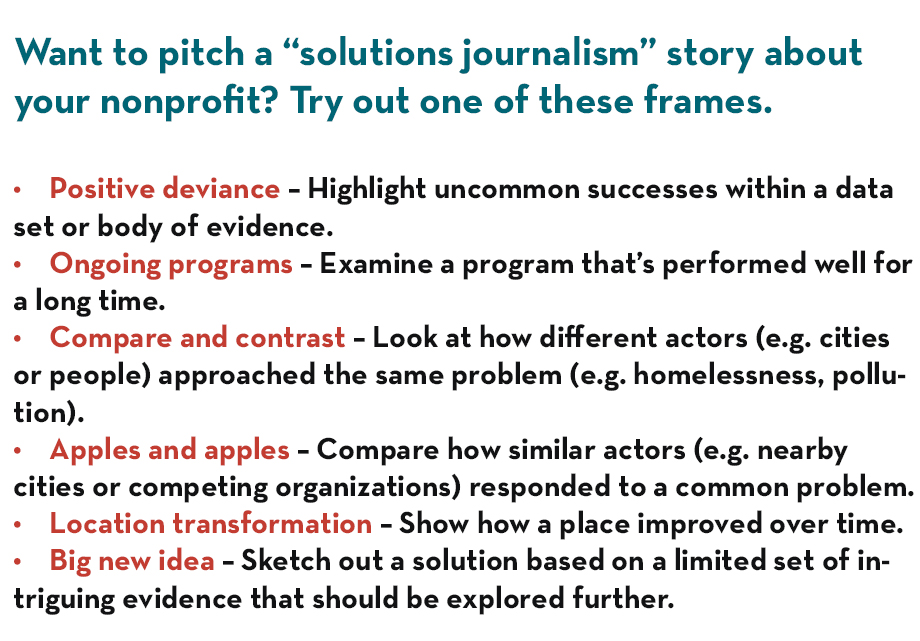Through “Solutions journalism” (dubbed “SoJo”) journalists report on social solutions with the same attention and rigor that is typically reserved for investigating social ills. Nonprofits can learn from these types of stories – and should try to pitch them more often.
Kathryn Thier says that, “in a newsroom excessive cynicism is a misdemeanor, but excessive gullibility is a felony.” Indeed, it’s true that – from muckraking to watchdog journalism – the culture of the fourth estate tends to focus on exposing problems.
However, as news outlets explore new types of storytelling in the digital realm, many are asking whether the journalist’s position on action needs to change. Likewise, more traditional news outlets are taking a closer look at the ideas and programs that could offer great promise to our society.
Kathryn is currently wrapping up her first semester at the University of Oregon teaching one of the country’s first university courses entirely devoted to solutions journalism. (Other programs exist at Temple University, Kent State University, Arizona State University, and Texas State University.) I caught up with her after the frank conference to discuss recent developments in her field.
Sacha: Just to set the table, what is solutions journalism?
Kathryn: The Solutions Journalism Network defines it as, “rigorous and compelling reporting about responses to social problems.” In order to be considered solutions journalism, four qualities must be present:
- How and why something is working
- Strong evidence that something is working
- Insight into how solution could be applied elsewhere
- Limitations – Obviously, one solution won’t work everywhere, and you need to be honest about that
It’s important to note that solutions journalism is a practice, not a movement. Really, it’s just using all the traditional practices of journalism, with a different frame.
Sacha: Is solutions journalism a new phenomenon, or did it grow out of an older tradition in journalism?
Kathryn: It’s both. Civic journalism was a movement in the ’80s, as journalists began to ask, “What are the effects of negative reporting on society?” Today there are a lot of different ideas bubbling up like “restorative narratives,” and “constructive journalism.” What’s new about solutions journalism is an effort to legitimize and codify certain newsroom practices.
Sacha: Do you see any resistance out there to solutions journalism?
Kathryn: When I worked in a newsroom, it felt like reporting on what’s going right was not allowed – unless it was a saccharine feature. Of course, not every story should use solutions journalism. But if we’re not reporting on what’s going right in the world, how are we giving the public all the information it needs?
Still, I think newsrooms are becoming more open to solutions journalism. Particularly with the digital revolution, audiences are showing that they want to engage.
When I teach solutions journalism, I ask students to think about: “What is the role of the journalist in society?” I will tell them about solutions journalism, but I want them to decide for themselves whether it’s the right approach.
Sacha: What evidence do you see of the public’s appetite for this type of journalism?
Kathryn: There’s some really interesting research on this topic. The Solutions Journalism Network and the Engaging News Project partnered on a report, which suggests that this kind of reporting does engage audiences differently. I’m about to start my own research project on this topic too.
Sacha: Personally, what got you interested in solutions journalism?
Kathryn: When I was a reporter at the Charlotte Observer, I worked on a story about seven African-American teenagers who died in a car crash. We really tried to determine if the police officers erred and even re-created the teenagers’ last night.
What we ultimately concluded that the police officer didn’t break any rules, but that the rules were outdated. This stimulated a lot of debate in the community. It was a very searing experience for me. I really began to question: what are we doing as journalists?
Later I wrote a story about a local barber. He was also a playwright and put on a play for the community, which basically said that the crash was everyone’s fault and that everyone was also absolved of any wrongdoing. When I wrote about this – the Letter to the Editor totally changed. People were struck by it.
Later I discovered the New York Times’ blog The Fixes, and the work of Tina Rosenberg and David Bornstein – who helped to found the Solutions Journalism Network. I was like, “Wow, this is what I love.” I really felt like this is how journalists can provide better information to society.
Sacha: What are a few of the best examples of Solutions Journalism you’ve seen recently?
Kathryn:
- The Corpus Christi Caller-Times did a series called “Behind Broken Doors” about domestic violence.
- The Fayetteville Observer’s “Seeking Safety” series looked at how 10 cities are fighting crime.
- The New York Times wrote about how Colorado cut teen pregnancy rate with long acting birth control.
- The Seattle Times’ Education Lab has also done great work.
Nota bene: Check on this “best of 2015” list from the Solutions Journalism Network.
